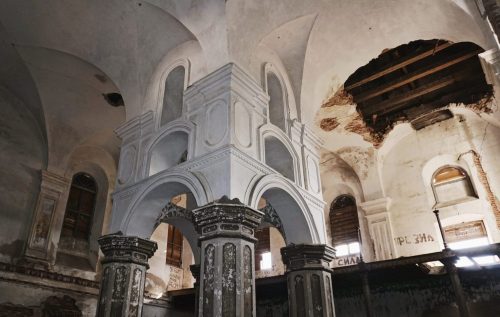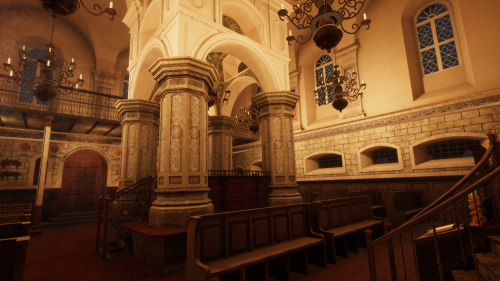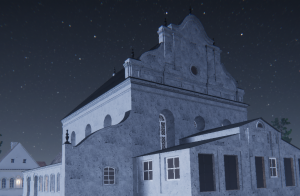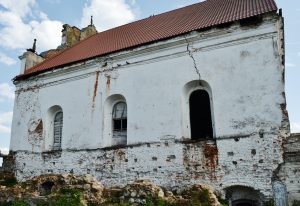The “Slonim Synagogue” VR tour – our contribution to the revival of Belarusian cultural heritage.
18.03.2023

A VR reconstruction and virtual tour of the Seventeenth-century Slonim Synagogue has been created – a first for Belarus.
A team of Belarusian specialists has completed the creation of the first project of its kind – a VR tour and reconstruction of the Great Choral Synagogue in Slonim, an important site of the country’s Jewish cultural heritage. The ambitious project united the efforts of researchers, historians, restorers, artists, 3D designers, and software engineers who combined archival information with high-tech modelling to recreate and preserve one of the oldest remaining synagogues of Belarus.
The project was organized and created by the Belarusian-Jewish Cultural Heritage Center in partnership with the Goethe Institute in Belarus, with Grigori Heifetz as curator. The project has been created within the #CivilSocietyCooperation Eastern Partnership program, with support from the German Federal Foreign Office.
The software solutions were developed by Exposit, while the “Bastalia” creative workshop handled the interior renovation of the synagogue.

The nearly yearlong efforts of the team resulted in the creation of a 15-minute virtual tour of the Slonim Synagogue in the time of its flourishment (17th – 19th century). Using a VR headset, one can dive into the past. The tour includes a general overview of Jewish history and culture, history of the synagogue, and a “visit” to the building in its original state: with restored murals, architectural elements, and archival audio recordings. At the end of the session users can compare the version of the synagogue after restoration with its current, decrepit state.
“The virtual project aimed at creating a hypothetical reconstruction of the Slonim Synagogue was based on measurement diagrams made by the “Bastalia” art workshop between 1991 and 1993. The modern phase of the project included investigation of previously undiscovered photographic documents from the 1930s, which made it possible to reconstruct lost fragments of murals and decorative furniture components inside the synagogue. We also analyzed Eastern Europe’s available synagogal murals. Seeing these analogs cemented the conclusion that the currently revealed mural fragments in Slonim are but a small fragment of Slonim’s artistry – it’s a fraction of the murals that were either lost or covered with later layers of paint” – a member of the “Bastalia art workshop noted.
The tour is based on a meticulously designed realistic 3D model of the synagogue with a detailed exterior, surrounding area, and interior. Any user who takes the tour can freely and voluntarily move around the structure using navigation tools and points of interest, study interior and exterior details, and get detailed descriptions of specific elements. The tour has been recorded in two languages – Russian and English – which allows any museum in the world to exhibit the project.

“Reconstruction of the Slonim Synagogue in a virtual space is a unique immersive experience within a cultural context, where historical heritage and new technologies merge into a single solution. These days, as Virtual Reality is increasingly aimed at creating imaginary videogame worlds and characters, the project organizers’ idea to recreate an authentic historic building became a true revelation not only for the development team, but for all of the company’s employees” – a spokesperson for Exposit said.
The VR reconstruction of the Slonim Synagogue became the pilot object of the Belarus Shtetl project. Shtetl is Yiddish (which used to be one of the four state languages in Belarus) for “small town”. It used to denote mostly Jewish-populated small towns that existed in Eastern Europe before the Holocaust. It is a significant part of Jewish history and a true cultural phenomenon. The project’s future plans include work on VR reconstructions of several other Belarusian sites, each depicting different periods, territories and architectural styles; development of multimedia solutions to recreate the shtetl environment.
 “We strive to find new approaches when working with our heritage. It is essential not only to cooperate with specialized organizations and experts, but also to involve as many young creatives as we can. Belarus Shtetl is a large multimedia project aimed at rethinking the history of Belarusian Jews with the aid of new technologies and modern means of communication. The format proposed and the solutions applied are most relevant to attract attention to the Belarusian-Jewish cultural heritage, and they may be available for both our country’s citizens and the rest of the world. In future, the multimedia exhibition can form the basis for the creation of a new modern Jewish museum in Belarus” – a representative of the Belarusian Jewish Cultural Heritage Center stated.
“We strive to find new approaches when working with our heritage. It is essential not only to cooperate with specialized organizations and experts, but also to involve as many young creatives as we can. Belarus Shtetl is a large multimedia project aimed at rethinking the history of Belarusian Jews with the aid of new technologies and modern means of communication. The format proposed and the solutions applied are most relevant to attract attention to the Belarusian-Jewish cultural heritage, and they may be available for both our country’s citizens and the rest of the world. In future, the multimedia exhibition can form the basis for the creation of a new modern Jewish museum in Belarus” – a representative of the Belarusian Jewish Cultural Heritage Center stated.
The Slonim Synagogue virtual tour is open for visitors on April 1 through 14 at the Belarus Shtetl exhibit at the “Korpus” culture center (Minsk, prospekt Masherova, 9/8). Exhibit opening hours are: Mon. – Sat. 14.00 – 20.00, Sun. – closed. Entry is free of charge. Advance booking at the link (https://widget.bookform.ru/50639) guarantees attendance of the 15-minute VR tour at a selected time period.
For reference:
The Belarusian-Jewish Cultural Heritage Center is a non-profit establishment founded in April 2019. The Center’s mission is to spread awareness of the rich Belrusian-Jewish cultural heritage, a more complete and objective representation of the Jewish population of Belarus within the national and international context; to preserve and enrich this heritage by organizing and supporting cultural and research projects, and educational programs in Belarus and abroad.
The Center’s activities are aimed at creating a full-fledged platform for a new museum and cultural center in Belarus.The Center’s projects include: the “Amy Winehouse: A Family Portrait” exhibition (with the Jewish Museum London); the “Moisej Nappelbaum. A Portrait of an Epoch” exhibition (Minsk – St. Petersburg); #UNOVIS100 – a large-scale series of events devoted to Vitebsk’s UNOVIS group of artists; the first Belarusian-Jewish Festival.
The Great Choral Synagogue in Slonim was erected in 1642 by the Jewish community. It is a landmark of the Baroque style. In the late 1800s the building was almost entirely destroyed by a fire and subsequently restored thanks to donations from local residents. After World War II, the synagogue was used as a warehouse, and later as a commercial space, after which it fell into disrepair.
In 2018, the Slonim Synagogue was chosen as one of the four most important synagogues of Europe in dire need of repair. It is included in the State Registry for historic and cultural valuables of Belarus.